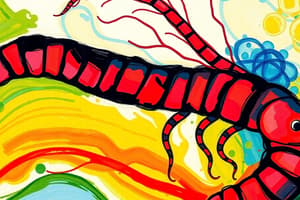Podcast
Questions and Answers
What is Phylum Nematoda commonly known as?
What is Phylum Nematoda commonly known as?
- Segmented worms
- Annelids
- Roundworms (correct)
- Flatworms
Which class is found in Phylum Nematoda and contains paired glandular structures called phasmids?
Which class is found in Phylum Nematoda and contains paired glandular structures called phasmids?
- Class Annelida
- Class Polychaeta
- Class Adenophorea
- Class Secernentea (correct)
What key feature distinguishes Class Adenophorea?
What key feature distinguishes Class Adenophorea?
- Segmented body
- Free living and parasitic species
- Presence of phasmids
- No phasmids (correct)
What are the characteristics of the phylum Nematoda?
What are the characteristics of the phylum Nematoda?
What does the term aschelminth refer to?
What does the term aschelminth refer to?
What is a pseudocoelomate?
What is a pseudocoelomate?
What is the function of the cuticle in nematodes?
What is the function of the cuticle in nematodes?
What is molting?
What is molting?
Define ecdysis.
Define ecdysis.
What is an amphid?
What is an amphid?
What is a phasmid?
What is a phasmid?
What is trichinosis?
What is trichinosis?
What is elephantiasis?
What is elephantiasis?
What causes heartworm disease in dogs?
What causes heartworm disease in dogs?
What are horsehair worms also known as?
What are horsehair worms also known as?
What is a zonite?
What is a zonite?
What are scalids?
What are scalids?
What are placids?
What are placids?
What is an introvert in the context of certain worms?
What is an introvert in the context of certain worms?
Flashcards are hidden until you start studying
Study Notes
Phylum Nematoda Overview
- Nematodes, commonly known as roundworms, comprise about 16,000 described species.
- They play various roles in ecosystems, including free-living and parasitic forms.
Class Secernentea (Phasmidea)
- Characterized by paired sensory structures known as phasmids located in the tail region.
- Amphids, similar but less developed structures, are found in the anterior end.
- Notable species include Ascaris, Enterobius, Rhabditis, Tubatrix, Necator, and Wuchereria.
- Approximately 5,000 species categorized under this class.
Class Adenophorea (Aphasmidia)
- Phasmids are absent in this class.
- Most species are free-living; however, some are parasitic.
- Key genera include Dioctophyme, Trichinella, and Trichuris, with around 3,000 species described.
Key Characteristics of Nematodes
- Triploblastic, bilateral symmetry, and vermiform in shape; unsegmented and pseudocoelomate.
- Body structure: round cross-section and covered by a layered elastic cuticle, with molting typical during juvenile growth.
- Features a complete digestive system with a mouth often surrounded by sensory-laden lips.
- Unique excretory systems typically involve one or two renette cells or collecting tubules.
- Body wall contains only longitudinal muscles, enabling specific locomotion.
Terminology and Concepts
- Aschelminth: Refers to phyla divided into those that do not molt (Lophotrochozoa) and those that do molt (Ecdysozoa), including Nematoda.
- Pseudocoelomate: Animals with a pseudocoelom, exemplified by aschelminths.
- Cuticle: A protective organic layer secreted by the hypodermis of many invertebrates.
- Molting: The shedding of exoskeleton or body covering, also known as ecdysis.
- Ecdysis: The process of shedding the exoskeleton in arthropods or the cuticle in aschelminths for growth.
Sensory Structures
- Amphid: Chemosensory organs located at the anterior end of certain nematodes.
- Phasmid: Sensory pits near the tail end of nematodes in the Secernentea class.
Disease Associations
- Trichinosis: An infection from Trichinella spiralis larvae, often from undercooked meat, leading to symptoms like muscular pain and fever.
- Elephantiasis: A chronic filarial disease caused by Wuchereria spp., affecting lymphatic vessels, mainly in tropical locations.
- Heartworm Disease: Parasitic infection in dogs due to Dirofilaria immitis nematode.
Other Related Terms
- Horsehair Worms: Pseudocoelomate animals from the phylum Nematomorpha, also known as Gordian worms.
- Zonite: The individual body unit of Kinorhyncha members.
- Scalid: Complex spines found on certain marine worms, serving various functions.
- Placid: Plates present on Kinorhyncha.
- Introvert: The retractable anterior section of certain worm types, capable of being introverted into the trunk.
Studying That Suits You
Use AI to generate personalized quizzes and flashcards to suit your learning preferences.




